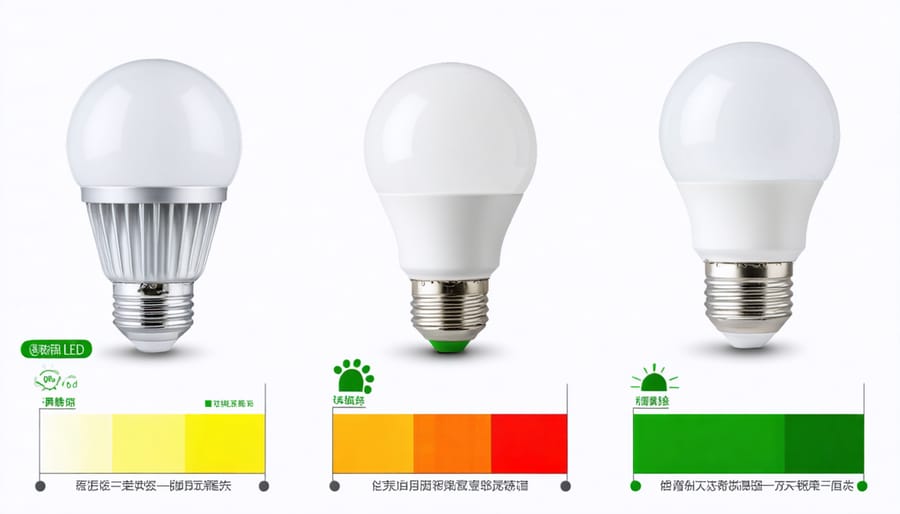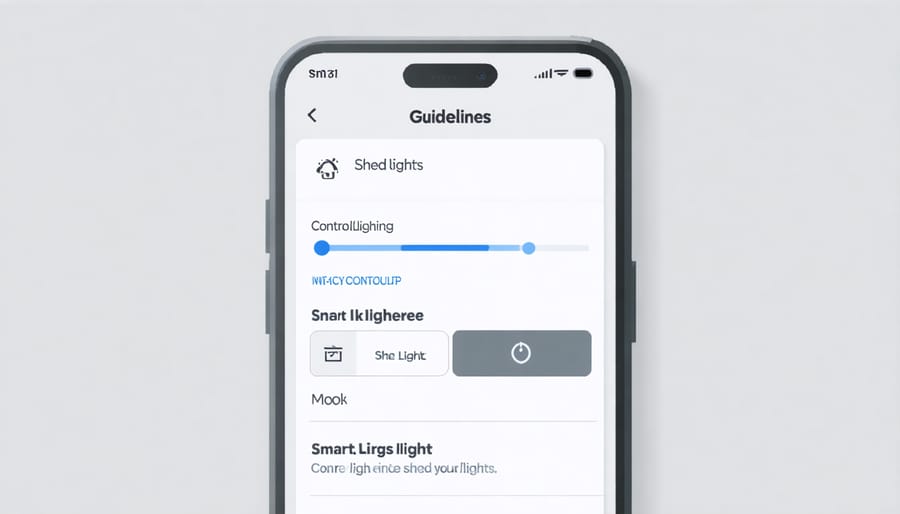Bright Ideas: Smart Lighting That Cuts Your Shed’s Energy Bills

Transform your energy bills and living spaces with modern smart interior lighting solutions that slash electricity costs while enhancing home comfort. LED technology now delivers professional-grade illumination at a fraction of traditional lighting costs, with modern fixtures using up to 75% less energy than conventional bulbs while lasting 25 times longer. Advanced motion sensors, dimming capabilities, and smart controls have revolutionized home lighting, making it possible to create perfectly lit spaces that automatically adjust to your needs while minimizing waste. Whether upgrading a single room or reimagining your entire home’s lighting design, energy-efficient solutions offer an impressive return on investment through reduced utility bills, improved functionality, and enhanced property value.
The Best Energy-Efficient Bulbs for Your Shed
LED Solutions
LED lighting has revolutionized the way we illuminate our spaces, offering an unbeatable combination of energy efficiency and longevity. Modern LED bulbs use up to 90% less energy than traditional incandescent bulbs while lasting up to 25 times longer. For a typical homeowner, switching to LED lighting can translate to significant savings – often $100 or more annually on electricity bills.
When selecting LED bulbs, consider both lumens (brightness) and color temperature. A warm white (2700-3000K) creates a cozy atmosphere, while daylight (5000-6500K) offers better task lighting. Most residential spaces benefit from 800-1600 lumens per fixture, depending on the room’s size and purpose.
Today’s LED options come in various styles, from classic bulb shapes to integrated fixtures and smart lighting solutions. Smart LED systems allow you to control brightness, color, and timing through your smartphone or voice commands, adding convenience and additional energy-saving opportunities.
Installation is typically straightforward, with most LED bulbs fitting standard fixtures. However, consider investing in dedicated LED fixtures for optimal performance and longevity. While LED bulbs cost more upfront than traditional options, their energy savings and reduced replacement frequency make them highly cost-effective over time. A quality LED bulb paying for itself through energy savings within 6-12 months of regular use.

Solar-Powered Lighting
Solar-powered lighting offers an eco-friendly and cost-effective solution for illuminating your shed while keeping energy bills in check. These systems harness the sun’s energy through solar panels, storing it in batteries for use when darkness falls. For detailed steps on setting up your system, check out our comprehensive solar lighting installation guide.
Popular solar lighting options include motion-activated security lights, path lights for safe access, and interior fixture kits that provide consistent illumination. When choosing solar lights, consider your local climate and typical sunlight exposure – areas with consistent sunny days will naturally yield better performance.
Installation is typically straightforward, with most systems requiring minimal tools and basic DIY skills. Position solar panels where they’ll receive maximum sunlight, usually on the shed’s roof or south-facing wall. For optimal performance, keep panels clean and angled correctly according to your geographical location.
Many modern solar lights come with smart features like automatic dusk-to-dawn operation, adjustable brightness levels, and even smartphone connectivity. These features help maximize efficiency while ensuring your shed remains well-lit exactly when you need it.
Remember to account for seasonal changes in daylight hours when planning your setup. Consider installing backup battery storage for extended periods of cloudy weather, ensuring reliable lighting year-round.

Smart Placement Strategies
Task Lighting Zones
Task lighting zones make a significant difference in how efficiently you use energy while ensuring adequate illumination where you need it most. Start by identifying your primary work areas – whether it’s a workbench, potting station, or tool organization area. Position bright, focused lights directly above these spaces, typically 24-36 inches from the work surface.
For a workbench, install LED strip lights or adjustable task lamps that can be positioned precisely where needed. This targeted approach allows you to use lower-wattage bulbs in other areas while maintaining optimal visibility for detailed tasks. Consider installing motion sensors for these zones to ensure lights are only on when you’re actively working.
Create separate lighting zones by installing individual switches for different areas. This way, you can illuminate only the space you’re using rather than the entire shed. For example, keep your general ambient lighting on a different circuit from your task lighting, allowing you to use brighter, more focused light only when necessary for specific projects while maintaining lower-level lighting for general navigation.
Natural Light Integration
Maximizing natural light is one of the most cost-effective ways to illuminate your space while reducing energy consumption. Start by strategically positioning windows or skylights to capture optimal daylight throughout the day. Consider installing light tubes or solar tubes, which can channel sunlight from your roof directly into darker areas of your space.
To blend natural and artificial lighting effectively, use light sensors or daylight harvesting systems that automatically adjust artificial lighting levels based on available natural light. Place workstations and frequently used areas near windows to take advantage of daylight, and use light-colored, reflective surfaces on walls and ceilings to help distribute natural light more effectively throughout the space.
For spaces with limited window options, consider using glass doors or installing additional windows where possible. Transparent or translucent roofing panels can also provide natural illumination while maintaining privacy. Remember to keep windows clean and unobstructed, and trim any outdoor vegetation that might block natural light from entering your space.
During peak sunlight hours, you may be able to rely entirely on natural light, significantly reducing your energy consumption and costs.
Money-Saving Control Systems
Motion Sensors and Timers
Installing motion sensors and timers in your shed is a game-changer for energy efficiency and convenience. These smart devices ensure lights are only on when needed, potentially reducing your energy consumption by up to 80%. Motion sensors automatically activate lights when you enter the shed and turn them off after a set period of inactivity, perfect for those times when your hands are full of tools or supplies.
For optimal placement, mount motion sensors in corners where they can detect movement across the entire space. Consider installing outdoor-rated sensors near entry points to illuminate your path before you even step inside. Most modern motion sensors offer adjustable sensitivity and duration settings, allowing you to customize them based on your needs and habits.
Timers provide another layer of control, especially useful if you follow a regular schedule. You can program them to turn lights on during specific hours or use astronomical timers that adjust to sunrise and sunset throughout the year. Some homeowners combine both systems – motion sensors for general use and timers for security lighting during evening hours.
When selecting these devices, look for weather-resistant options rated for outdoor use. Many modern systems now offer smartphone connectivity, allowing you to monitor and adjust settings remotely. This feature proves invaluable when you’re away and want to maintain the appearance of activity around your property.
Smart Controls and Apps
Today’s lighting technology puts complete control at your fingertips with innovative smart control systems and user-friendly apps. These modern solutions make managing your shed’s lighting more convenient and energy-efficient than ever before.
Motion sensors automatically turn lights on when you enter and off when you leave, eliminating wasted energy from forgotten lights. Smart timers can be programmed to match your schedule, ensuring your shed is well-lit only when needed. Many systems even adjust brightness based on natural light levels, maximizing energy savings while maintaining optimal visibility.
Mobile apps let you control your shed’s lighting from anywhere using your smartphone. You can check if lights were left on, adjust brightness levels, or set up automated schedules with just a few taps. Some apps even provide energy usage reports, helping you track consumption and identify ways to save more.
Voice-controlled options work with popular smart home assistants like Alexa or Google Home, letting you manage your shed’s lighting hands-free. This feature is especially helpful when carrying tools or supplies. Many systems also offer geofencing, which can automatically control your lights based on your location, ensuring they’re only on when you’re nearby.
These smart solutions typically pay for themselves through reduced energy costs and extended bulb life, making them a practical investment for any shed owner.

Making the switch to energy-efficient lighting in your shed is a smart investment that pays dividends in both the short and long term. By implementing LED bulbs, motion sensors, and natural lighting solutions, you can significantly reduce your energy consumption while maintaining optimal visibility in your storage space. Not only will these changes lead to lower electricity bills, but they also contribute to a more sustainable environment.
Remember that proper planning is key to success. Start by assessing your current lighting needs and gradually upgrade to energy-efficient alternatives. Consider the initial investment as a stepping stone to long-term savings, with most LED bulbs paying for themselves within the first year through reduced energy costs.
The combination of smart lighting controls, proper placement, and energy-efficient bulbs creates an ideal lighting system that’s both functional and cost-effective. By taking action today, you’ll create a more environmentally friendly storage space while enjoying improved lighting quality and reduced maintenance requirements for years to come. Don’t wait to make these valuable improvements – your wallet and the planet will thank you.

